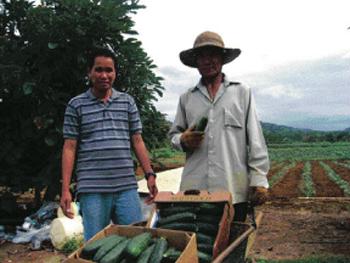KILAUEA — Kilauea farmer Sam Pangdan sensed change was in the air when it came to erecting wind turbines on his property. Nearly a year and a half later, he is still waiting for that change to blow through the
KILAUEA — Kilauea farmer Sam Pangdan sensed change was in the air when it came to erecting wind turbines on his property.
Nearly a year and a half later, he is still waiting for that change to blow through the county Planning Commission, which worries the alternative energy resource could be a hazard for endangered birds and bats.
“We have competing interests between clean energy and birds,” said Commissioner Hartwell Blake, at a commission meeting last month.
He said the federal Endangered Species Act is vague in defining what constitutes a flight path for birds.
“To say it’s a flight path because someone saw a bird flying through there is ridiculous,” Blake said. “By those standards all of Kaua‘i is a flight path.”
Today the commission is scheduled to make a decision on Pangdan’s request for a use permit for a Skystream wind turbine. He is seeking a height variance for a 66-foot tall turbine.
“Other farmers are waiting to see what happens with our application,” said Pangdan’s son, Sam Jr., who owns and manages the zucchini and cucumber farm with his father. “But it seems to me that things will work out because birds have an easier time going around a turbine than airplanes.”
The Federal Avian Administration National Wildlife Strike Database recorded 238 bird strikes at Lihu‘e airport between 2004 and 2008.
“Small scale wind turbines aren’t a threat to birds,” said Skystream marketing manager Miriam Robbins. “The argument that it’s a hazard results from the discussion on large-scale wind farms.”
The company has sold over 5,000 units in the United States since 2007 and has not encountered a problem with avian deaths.
Kaua‘i County Attorney Ian Jung advised the commission to err on the side of caution, however, considering the strict penalties of the federal Division of Forestry and Wildlife.
“Any agency can be liable for an incidental killing of a bird,” Jung said. “If we allow this then it could be possible that the Planning Commission could be responsible for violating an Endangered Species Act.”
Commission Chair James Nishida agreed, saying, “The law is strict and even one death is too many.”
The commission recently reviewed a proposed county ordinance that addresses height variances and issues of liability, with the hopes of facilitating the process for residents and farmers looking to install wind turbines.
“What we’re working on for Pangdan is addressed in the Wind Ordinance,” said County Planner Ka‘Aina Hull. “But until the County Council passes it, there’s no guarantee how it will exist.”
Rather than wait with crossed fingers for an undetermined amount of time for the elected officials to come to a decision, Pangdang said he thought it would be more efficient to take the matter into his own hands.
“We’re patient people, but we just didn’t want to sit around and hope something would get passed,” he said.
The turbine would supply Pangdan’s eight-acre farm with 2.4 kilowatt-hours of energy, enough to power 90 percent of its operational utilities, such as four industrial-sized refrigerators for keeping produce fresh.
“We have turbines out there now,” said Commissioner Caven Raco at last month’s meeting, referring to unpermitted turbines that exist on the island.
“This would set a precedence for other windmills that are existing and hopefully get them permitted.”


